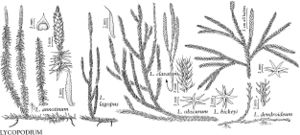Difference between revisions of "Lycopodium annotinum"
Sp. Pl. 2: 1103. 1753.
FNA>Volume Importer |
FNA>Volume Importer |
||
| Line 17: | Line 17: | ||
}}<!-- | }}<!-- | ||
| − | --><span class="statement" id="st- | + | --><span class="statement" id="st-undefined" data-properties=""><b>Horizontal </b>stems on substrate surface. <b>Upright</b> shoots clustered, mainly unbranched or sparsely branching mainly at base, 1.2–1.6 cm diam.; annual bud constrictions abrupt and conspicuous. <b>Lateral</b> branchlets few and like upright shoots but annual bud constrictions absent. <b>Leaves</b> spreading to reflexed, dark green, linear-lanceolate, (2.5–)5–8 × 0.6–1.2 mm; margins closely and shallowly dentate mainly in distal 1/2; apex sharply pointed, lacking hair tip. <b>Strobili</b> solitary, sessile on shoots, 15–30 × 3.5–4.5 mm. <b>Sporophylls</b> (1.5–)3.5 × 0.7(–2) mm, abruptly narrowed to pointed tip. <b>2n</b> = 68.</span><!-- |
-->{{Treatment/Body | -->{{Treatment/Body | ||
| Line 47: | Line 47: | ||
|publication year=1753 | |publication year=1753 | ||
|special status= | |special status= | ||
| − | |source xml=https://jpend@bitbucket.org/aafc-mbb/fna- | + | |source xml=https://jpend@bitbucket.org/aafc-mbb/fna-data-curation.git/src/9216fc802291cd3df363fd52122300479582ede7/coarse_grained_fna_xml/V2/V2_334.xml |
|genus=Lycopodium | |genus=Lycopodium | ||
|species=Lycopodium annotinum | |species=Lycopodium annotinum | ||
| − | |||
| − | |||
| − | |||
| − | |||
| − | |||
| − | |||
| − | |||
| − | |||
| − | |||
| − | |||
| − | |||
| − | |||
| − | |||
| − | |||
| − | |||
| − | |||
| − | |||
| − | |||
| − | |||
| − | |||
| − | |||
| − | |||
| − | |||
| − | |||
| − | |||
| − | |||
| − | |||
| − | |||
| − | |||
}}<!-- | }}<!-- | ||
-->[[Category:Treatment]][[Category:Lycopodium]] | -->[[Category:Treatment]][[Category:Lycopodium]] | ||
Revision as of 14:17, 27 July 2019
Horizontal stems on substrate surface. Upright shoots clustered, mainly unbranched or sparsely branching mainly at base, 1.2–1.6 cm diam.; annual bud constrictions abrupt and conspicuous. Lateral branchlets few and like upright shoots but annual bud constrictions absent. Leaves spreading to reflexed, dark green, linear-lanceolate, (2.5–)5–8 × 0.6–1.2 mm; margins closely and shallowly dentate mainly in distal 1/2; apex sharply pointed, lacking hair tip. Strobili solitary, sessile on shoots, 15–30 × 3.5–4.5 mm. Sporophylls (1.5–)3.5 × 0.7(–2) mm, abruptly narrowed to pointed tip. 2n = 68.
Habitat: Swampy or moist coniferous forests, mountain forests, and exposed grassy or rocky sites
Elevation: 0–1850 m
Distribution

Greenland, St. Pierre and Miquelon, Alta., B.C., Man., N.B., Nfld., N.W.T., N.S., Ont., P.E.I., Que., Sask., Yukon, Alaska, Ariz., Colo., Conn., Idaho, Ky., Maine, Md., Mass., Mich., Minn., Mont., N.H., N.J., N.Mex., N.Y., N.C., Ohio, Oreg., Pa., R.I., Tenn., Utah, Vt., Va., Wash., Wis., Wyo.
Discussion
This widespread and common club-moss has been divided into various forms or varieties, some of which have been treated as species. Present evidence supports the hypothesis that these are environmentally induced forms, the most distinctive of which has been called Lycopodium annotinum var. alpestre C. Hartman, with leaves only 2.5–6 mm, very leathery, entire-margined, and appressed. Plants intermediate between this and L. annotinum var. annotinum are a form that has been called var. pungens (Bachelot de la Pylaie) Desvaux, an invalid name. Both are found in cold, bleak, northern or high elevation habitats. The species should be studied in detail to determine whether it contains any groups that should be recognized taxonomically.
Lycopodium clavatum group
Selected References
None.
